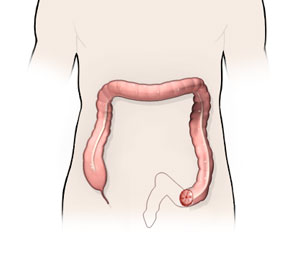Anterior Resection

Anterior resection is a surgical procedure for partial or complete removal of the rectum. It also involves the removal of the surrounding lymph nodes to prevent the spread of cancer and its recurrence.
The rectum is the lowest part of your digestive system and stores your body’s metabolic waste. The rectum lies next to the colon and is a part of the large intestine (large bowel).
Indications for Anterior Resection
Anterior resection surgery is indicated for people diagnosed with:
- Rectal cancer
- Rectosigmoid cancer, this involves your rectum and the S-shaped last part of your large intestine called the sigmoid colon, leading into the rectum
Pre-operative Preparation for Anterior Resection
You will be given an oral bowel preparation 24 hours before your surgery except in patients with obstructing cancers. The bowel prep helps to clear your bowels of faecal matter, so your surgeon has a clear view to work. You should consume only clear liquids such as water, lemonade, or energy drinks before your surgery.
Procedure of Anterior Resection
Anterior resection can be performed in two ways, either using the open approach or through minimally invasive laparoscopic surgery. The choice of procedure will depend on your health and the spread of cancer and your surgeon’s discretion.
The common steps for both approaches are listed below:
- You will be placed on the operating table with the help of stirrups.
- You may be placed in a Trendelenburg position, also called Lloyd Davis position, with legs apart or head down Lithotomy. It is a modification of the supine position with the hips flexed at 15 ° basic angle and a 30 ° head-down tilt.
- You will be administered general anaesthesia.
- You will also be given intravenous antibiotics at the same time to prevent infection during and after the surgery.
- You may also be given medications such as heparin to prevent blood clots.
Open Approach Anterior Resection: Laparotomy
The procedure for open-approach anterior resection involves the following steps:
- A single long incision is made along the midline of your lower abdomen.
- The sigmoid colon is separated from the side of the abdominal wall.
- The autonomic nerves (nerves that control the internal organs) and the ureter are left untouched and unharmed.
- The blood vessels and lymph nodes are identified and divided at the proper level.
- The bowel is divided and pulled forward.
- The cancerous part of the rectum is removed.
- The surrounding lymph nodes and blood vessels are also removed to prevent the spread of cancer.
- After removing the rectum, the healthy ends are joined together using either a surgical stapler or via stitches (sutures) and is called anastomosis.
- Upon completion of the procedure, the abdominal incision is closed.
Anterior Resection through Laparoscopic (Keyhole) Surgery
The procedure for laparoscopic (keyhole) anterior resection involves the following steps:
- A few small incisions, around 4 to 5 measuring about one centimetre are made in the middle of your lower abdomen.
- The laparoscope, a thin tube with a camera attached to one end, is inserted through one of the incisions to view the internal organs.
- Through the other incisions, your surgeon inserts the operating instruments.
- One of the incisions is made slightly longer to remove the rectum and surrounding lymph nodes.
- After removing the cancerous mass, the laparoscope is removed, and the incisions are closed.
Post-operative Care after Anterior Resection
You will be required to stay in the hospital for 4 to 7 days. Within the first 24 to 48 hours of your surgery, you will be given:
- Oxygen through a face mask, if required.
- Intravenous (IV) nutrition through a drip into a vein in one of your arms.
- A urinary catheter to drain urine from the bladder.
- Pain relief medications though IV or epidural route (spine injection).
Nutrition
You will be required to begin oral food consumption. Initially, you will be given liquids and slowly transition to solid foods.
Motion
You will be recommended to move around as soon as possible to regain strength.
You will be trained on pelvic floor exercises to strengthen your abdominal and rectal muscles.
You will be discharged based on your recovery. The catheters will be removed beforehand. Healing is faster in laparoscopic surgeries.
However, you should contact your surgeon if you experience fever, severe abdominal pain or rectal bleeding after discharge to home.
What are the Risks and Complications of Anterior Resection?
As with any surgical procedure, anterior resection may also be associated with certain risks and complications. These include:
- Infection
- Bleeding
- Formation of blood clots in the veins in your legs: deep vein thrombosis or in your lungs: pulmonary embolism
- Injury to the surrounding organs such as the bladder, the ureter, and the small intestine
- Difficulty in urination
- Difficulty to control your bowels in the first few weeks post-surgery
- Leakage from the anastomosis: the site where your bowel is sutured together








